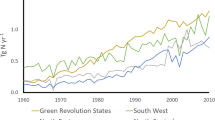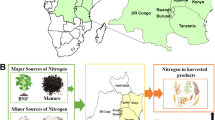Abstract
As the Thai economy grew rapidly after 1985, agriculture became more intensive through the increasing use of chemical fertilizer and mechanization. This study aimed to analyze the nitrogen (N) cycle related to agricultural activities in Khon Kaen Province in Thailand during 1990–1992 and 2000–2002, and on the changes in utilization of local organic resources and the N load to the environment. A model of the N cycle was constructed including compartments for farmland, crop yield, crop residue, food factory, livestock, humans, market, hydrosphere and atmosphere. N flows among the compartments in the model were estimated from data derived from Thai agricultural statistics, related reports and journal articles, interviews with farmers and food factory staff, field observation and information from Thai experts. N flow through livestock declined because of a decrease in the number of buffalo raised, which reduced the production of animal manure. N returned to farmland in crop residues increased because sugarcane cultivation, and crop residues, increased and the burning of rice straw decreased. An increase in chemical fertilizer application increased N input to farmland for crop production. N balance in farmland changed from −27 kg ha−1 year−1 in 1990–1992 to +6 kg ha−1 year−1 in 2000–2002, which improved soil N depletion. Because N leaching and erosion from farmland were low, water pollution in farmland is expected to be low. Human waste was not used or treated, and water pollution from human waste would be expected in housing areas. Analysis of indices of the N cycle showed that the stock of soil N in farmland supported agricultural production in 1990–1992, and that N inflow from outside the area (chemical fertilizer) supported agricultural production in 2000–2002. However, efficiency of N use for agricultural production did not improve.

Similar content being viewed by others
References
Aarts HFM, Biewinga EE, van Keulen H (1992) Dairy farming systems based on efficient nutrient management. Neth J Agric Sci 40:285–299
AICAF (1982) Rakkasei (Groundnuts). AICAF, Tokyo (in Japanese)
AICAF (1986) Nettai no kakin (Poultry of tropical area). AICAF, Tokyo (in Japanese)
AICAF (1991) Nettai no shuyou mame rui (Main legume in tropical zone). AICAF, Tokyo (in Japanese)
Ando S, Muenchang S, Thippayarugs S, Prasertsak P, Matsumoto N, Yoneyama T (2002) Evaluation of sustainability of sugarcane production in Thailand based on nitrogen fixation, efficiency of nitrogen fertilizer and flow of organic matters. In: Ito O, Matsumoto N (eds) Development of sustainable agricultural system in Northeast Thailand through local resource utilization and technology improvement. JIRCAS working report 30. JIRCAS, Tsukuba, pp 61–64
Antikainen R, Lemola R, Nousiainen JI, Sokka L, Esala M, Huhtanen P, Rekolainen S (2005) Stocks and flows of nitrogen and phosphorus in the Finnish food production and consumption system. Agric Ecosyst Environ 107:287–305. doi:10.1016/j.agee.2004.10.025
Center for Agricultural Statistics (1993) Agricultural statistics of Thailand—Crop year 1992/93. Office of Agricultural Economics, Ministry of Agriculture and Co-operatives, Bangkok, p 266
Center for Agricultural Statistics (2003) Agricultural statistics of Thailand—Crop year 2002/03. Office of Agricultural Economics, Ministry of Agriculture and Co-operatives, Bangkok
DOAE, FAO (1992a) Maize. Fertilizer application. Soil and fertilizer. Department of Agricultural Extension, Bangkok, p 38
DOAE, FAO (1992b) Rice. Fertilizer application. Soil and fertilizer. Department of Agricultural Extension, Bangkok, p 33
DOAE, FAO (1992c) Groundnut. Fertilizer application. Soil and fertilizer. Department of Agricultural Extension, Bangkok, p 40
DOAE, FAO (1992d) Kenaf. Fertilizer application. Soil and fertilizer. Department of Agricultural Extension, Bangkok, p 43
FAO (2004) FAO statistical yearbook 2004 Vol. 1/2 (Issue 1). FAO, p 192
FAOSTAT (2008a) Agricultural tractor, In use, machinery, ResourceSTAT, Resources, FAOSTAT Agriculture. http://www.faostat.org. Cited 23 July 2008
FAOSTAT (2008b) Production quantity of eggs, meat and milk, Livestock primary and processed, ProdSTAT, Production, FAOSTAT Agriculture. http://www.faostat.org. Cited 29 Aug 2008
FAOSTAT (2008c) Export and import of eggs, meat and milk, detailed trade data, TradeSTAT, trade, FAOSTAT agriculture. http://www.faostat.org. Cited 29 Aug 2008
Field Crops Institute (1994) Mungbean. Field crops cultivation. Department of Agriculture, Bangkok, p 83
Finn JT (1980) Flow analysis of models of the Hubbard Brook ecosystem. Ecology 61:562–571. doi:10.2307/1937422
Frissel MJ (1978) Cycling of mineral nutrients in agricultural ecosystems. Elsevier, Amsterdam
Furuya Y (1962) Soybean and environment. In Sakumotsu Taikei (Outline of crops) Vol 4 Mamerui (Pulse), Yokendo, Tokyo, p 104 (in Japanese)
Gollenhon N, Caswell M, Ribaudo M, Kellogg R, Lander C, Letson D (2001) Confined animal production and manure nutrients. ERS Agriculture information bulletin 771. www.ers.usda.gov/publications/aib771. Cited 11 Sep 2007
Granstedt A (2000) Increasing the efficiency of plant nutrient recycling within the agricultural system as a way of reducing the load to the environment—experience from Sweden and Finland. Agric Ecosyst Environ 80:169–185. doi:10.1016/S0167-8809(00)00141-9
Harashina K, Takeuchi K, Tsunekawa A, Arifin HS (2003) Nitrogen flows due to human activities in the Cianjur-Cisokan watershed area in the middle Citarum drainage basin, West Java, Indonesia: a case study at hamlet scale. Agric Ecosyst Environ 100:75–90. doi:10.1016/S0167-8809(03)00173-7
IMF (2007) World economic outlook database, October 2007. International Monetary Fund
International Fertilizer Industry Association (2007) Fertilizer consumption statistics. IFADATA statistics online, www.fertilizer.org/ifa/statistics/IFADATA. Cited 23 July 2008
Jansons V, Busmanis P, Dzalbe I, Kirsteina D (2003) Catchment and drainage field nitrogen balances and nitrogen loss in three agriculturally influenced Latvian watersheds. Eur J Agron 20:173–179. doi:10.1016/S1161-0301(03)00072-8
Jordan TE, Correll DL, Weller DE (1997) Effects of agriculture on discharges of nutrients from coastal plain watersheds of Chesapeake Bay. J Environ Qual 26:836–848
Kawashima T, Pholpark S, Sumamal W, Boonpakdee W, Srihakim S (1998) Mineral status of dairy cattle and available mineral sources in Northeast Thailand. In: Kawashima T, Vijchulata P (eds) Status and requirement of minerals in ruminants in Thailand–Current knowledge and future research-. JIRCAS working report 10. JIRCAS, Tsukuba, pp 63–73
Kearl LC (1982) Nutrient requirements of ruminants in developing counties. International Feedstuffs Institute, Utah Agricultural Experiment Station, Utah State University, Logan, pp 82–87
Kimura SD, Hatano R (2007) An eco-balance approach to the evaluation of historical changes in nitrogen loads at a regional scale. Agric Syst 94:165–176. doi:10.1016/j.agsy.2006.08.005
Kimura SD, Liang L, Hatano R (2004) Influence of long-term changes in nitrogen flows on the environment: a case study of a city in Hokkaido, Japan. Nutr Cycl Agroecosyst 70:271–282. doi:10.1007/s10705-004-0532-4
Kitano S, Song S, Kada R (2003) An analysis on regional circulation of organic resources and the possible ways to recycle: the case study of Ayabe City, Kyoto, Japan. J Jap Agric Syst Soc 19(1):51–60
Liang L, Nagumo T, Hatano R (2005) Nitrogen cycling with respect to environmental load in farm systems in Southwest China. Nutr Cycl Agroecosyst 73:119–134. doi:10.1007/s10705-005-0074-4
Liu C, Wang Q, Mizuochi M, Yang Y, Ishimura S (2007) Human behavioral impact on nitrogen flow—A case study of the rural area of the middle of lower reaches of Changjiang River, China. J Jap Agric Syst Soc 23(4):305–316
Liu C, Watanabe M, Wang Q (2008) Changes in nitrogen budgets and nitrogen use efficiency in the agroecosystems of the Changjiang river basin between 1980 and 2000. Nutr Cycl Agroecosyst 80:19–37. doi:10.1007/s10705-007-9118-2
Matsumoto N (2000) Development of estimation method and evaluation of nitrogen flow in regional areas. Bull Natl Inst Agro-Environmental Sci 18:81–152
Matsumoto N, Paisancharoen K, Hakamata T (2008) Carbon balance in maize fields under cattle manure application and no-tillage cultivation in Northeast Thailand. Soil Sci Plant Nutr 54:277–288. doi:10.1111/j.1747-0765.2007.00223.x
Mishima S (2002) The recent trend of agricultural nitrogen flow in Japan and improvement plans. Nutr Cycl Agroecosyst 63:151–163. doi:10.1023/A:1021111117622
Miwa E, Oda K, Matsumoto N (2006) Analysis of nitrogen load to the environment based on nitrogen flow in food supply system of Japan. Jpn J Soil Sci Plant Nutr 77:627–634
Nagumo T, Hatano R (2000) Impact of nitrogen cycling associated with production and consumption of food on nitrogen pollution of stream water. Soil Sci Plant Nutr 46:325–342
National Statistical Office (2001) Population and Housing Census 2000, Khon Kaen Province. http://web.nso.go.th/eng/en/pop2000/finalrep/khonkhaenfn.pdf. Cited 23 July 2008
Olsthoorn CSM, Fong NPK (1998) The anthropogenic nitrogen cycle in the Netherlands. Nutr Cycl Agroecosyst 52:269–276. doi:10.1023/A:1009724024770
National Agricultural Research Organization (2002) Standard tables of feed composition in Japan (2001). Japan Livestock Industry Association, Tokyo (in Japanese with English)
Paisancharoen K, Matsumoto N (2002) Utilization of organic resources in cassava farming in Northeast Thailand. In: Ito O, Matsumoto N (eds) Development of sustainable agricultural system in Northeast Thailand through local resource utilization and technology improvement. JIRCAS working report 30. JIRCAS, Tsukuba, pp 43–47
Pollution Control Department (2005) River water quality in Thailand. www.pcd.go.th. Cited 29 Mar 2006 (in Thai)
Pramanee P, Misri N, Sansayawichai T, Ary K, Srisingh S (1997) The survey of sugarcane soil and fertilizer management. Thai J Cane Sugar 4(3):34–48
Putthacharoen S, Howeler RH, Jantawat S, Vichukit V (1998) Nutrient uptake and soil erosion losses in cassava and six other crops in a Psamment in eastern Thailand. Field Crops Res 57:113–126. doi:10.1016/S0378-4290(97)00119-6
Resources Council, Science and Technology Agency, Japan (2000) Standard tables of food composition in Japan, 5th edn. National Printing Bureau, Ministry of Finance, Tokyo
Schlecht E, Hiernaux P (2004) Beyond adding up inputs and outputs: process assessment and upscaling in modelling nutrient flows. Nutr Cycl Agroecosyst 70:303–319. doi:10.1007/s10705-004-0765-2
Sinthuprama S, Tiraporn C, Watananonta W (1988) Cassava breeding in Thailand. In: Howeler Kawano (ed) Cassava breeding and agronomy research in Asia. CIAT, Bangkok, pp 9–19
Statistics Division FAO (2005) Food consumption pattern of main food items, dietary protein. Food security statistics, diet composition. http://www.fao.org/es/ess/faostat/foodsecurity/Files/DietFoodItemsProtein_en.xls. Cited 29 Oct 2007
Stoorvogel JJ, Smaling EMA, Janssen BH (1993) Calculating soil nutrient balances in Africa at different scales. I. Supra-national scale. Fert Res 35:227–235. doi:10.1007/BF00750641
Sugishima H (1962) Hemp. In Sakumotsu Taikei (Outline of crops), vol 10. Sen-irui (Fiber crops), Yokendo, Tokyo, p 106
Suwanarit A, Roongtanakiat N, Rungchuang J, Thongdaeng S (1996) 15 N-aided studies on effects on maize and balance sheets of different forms of N fertilizer. Kasetsart J Nat Sci 30(2):232–240
Takenaka Y, Hata T (2002) Improvement about nitrogen flow of upland and livestock farming on Tokachi-region in Hokkaido. Res Bull Natl Agric Res Cent Hokkaido Region 177:133–149
Watanabe T, Nagumo T (2002) Nitrogen flow in Can Tho Province of the Mekong Delta. In: Miyata S (compiled) Development of new technologies and their practice for sustainable farming systems in the Mekong Delta. JIRCAS working report 26, JIRCAS, Tsukuba, pp 51–55
Wijnhoud JD, Konboon Y, Lefroy RDB (2003) Nutrient budgets: sustainability assessment of rainfed lowland rice-based systems in northeast Thailand. Agric Ecosyst Environ 100:119–127. doi:10.1016/S0167-8809(03)00180-4
Williams PEV (1995) Animal production and European pollution problems. Anim Feed Sci Technol 53(2):135–144. doi:10.1016/0377-8401(95)02017-T
Woli KP, Nagumo T, Hatano R (2002) Evaluating impact of land use and N budgets on stream water quality in Hokkaido, Japan. Nutr Cycl Agroecosyst 63:175–184. doi:10.1023/A:1021146707412
Wongwiwatchai C, Thippayarugs S, Sansayawichai T, Pintasen S, Matsuo K (2002) Prevalent agricultural practices and soil fertility in sugarcane cropping in Northeast Thailand. In: Ito O, Matsumoto N (eds) Development of sustainable agricultural system in Northeast Thailand through local resource utilization and technology improvement. JIRCAS working report 30. JIRCAS, Tsukuba, pp 103–109
Yoshioka S (1987) Compilation report on soil fertility in Northeast Thailand. Agricultural Development Research Center in Northeast Thailand, Khon Kaen
Zessner M, Kaas T, Brunner PH (1996) Regional materials accounting of nitrogen in upper Austria. Water Sci Technol 33(4–5):89–97. doi:10.1016/0273-1223(96)00218-1
Acknowledgments
This study was conducted under the JIRCAS Project titled Comprehensive Studies on Sustainable Agricultural Systems in Northeast Thailand (1996–2002), and was funded in part by the JIRCAS Project titled Development of Technologies to Utilize Biomass Resources in Southeast Asia (2006–2010) and by Japan Science and Technology Agency (ASEAN Biomass 2004–2006 and Sustainable Biomass Use Technology Development in Asia 2007–2009). We thank the National Research Council of Thailand for its invaluable advice and assistance.
Author information
Authors and Affiliations
Corresponding author
Appendices
Appendices
Rights and permissions
About this article
Cite this article
Matsumoto, N., Paisancharoen, K. & Ando, S. Effects of changes in agricultural activities on the nitrogen cycle in Khon Kaen Province, Thailand between 1990–1992 and 2000–2002. Nutr Cycl Agroecosyst 86, 79–103 (2010). https://doi.org/10.1007/s10705-009-9275-6
Received:
Accepted:
Published:
Issue Date:
DOI: https://doi.org/10.1007/s10705-009-9275-6




